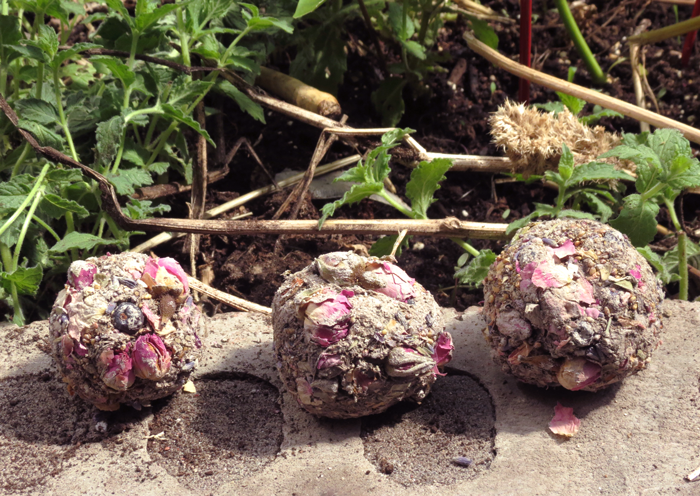I stumbled upon some alluring images the other day of colored seed bombs. I was interested in purchasing a few but they were sold out. Luckily there were no more left, because it only enforced my determination to learn more about them. I did a little research trying to find a local carrier, when it suddenly came to me why don’t I just make them myself!”
I remembered I had a bag of Wildflower seeds stacked away that I had bought not to long ago to attract hummingbirds. When I saw the ingredients called for clay, composte, water, and wildflower seeds I was really excited because I was already equipped and ready to go. There were a few different recipes to choose from, some with coloured recycled paper, but I opted for the more ancient traditional one made with clay. Since they lacked colour, I decided to just add a bit of rose petals, lavender, and calendula, elderberry seeds, and sumac in the mix to give it a subtle natural colour boost.
The plan is to Seed Bomb Valhalla this weekend! They say its best to bomb just before rainfall. Looking forward to see the mysterious flowers, that will one day miraculously bloom at Valhalla.
Ps: you might want to give people heads up that the seed bombs are not edible (hence clay & compost ) as you can see by the picture they could easily be mistaken for dessert 😉
What are Seed Bombs?
A seed bomb is a seed that has been wrapped in soil materials, usually a mixture of clay and compost, and then dried. Essentially, the seed is ‘pre-planted’ and can be sown by depositing the seed ball anywhere suitable for the species, keeping the seed safely until the proper germination window arises. Seed balls are an easy and sustainable way to cultivate plants in a way that provides a larger window of time when the sowing can occur. They also are a convenient dispersal mechanism for guerrilla gardeners and people with achy backs.
History
Seed bombs may have been used by the Ancient Egyptians to seed the receding banks of The Nile after annual floods. They have been used in Asia and elsewhere, especially in arid regions, because of their ability to keep the seeds safe until conditions are favorable for germination, and the ease at which they can be distributed.
In the Carolinas in the 1700’s, West African slaves, predominantly women, were brought in to cultivate rice using a seed ball technique that was used in Africa. Rice seeds were coated in clay, dried, and pressed into the mud flats with the heel of the foot. This served two purposes, protecting the seed from the birds, and also preventing it from floating off when the fields were flooded.
More recently, Japanese agricultural renegade, Masanobu Fukuoka, began exploring the use of seed balls (nendo dango in Japanese) to help improve food production in post WWII Japan. His research and outreach efforts has brought the seed ball back into the public eye. Today, seed balls are fun for green-minded kids and adults, and are also an important tool of the guerrilla gardening movement.
Ingredients
Air Dry Clay
Water
Compost
Wild flower Seeds ( preferably organic non gmo if possible)
*Optional: Dried Lavender, Elderberry seeds, Roses, Calendula, sumac for color.
Directions
For the dried clay mix 5 parts clay with 1 part compost and 1 part flower seeds, put some careful drops of water into the mixture (make sure not to make it into a goopy mess), Knead with hands into a ball, flatten it out and cut to desired size. Now just make into a small ball and let it dry in the sun. If you want to add color, roll the balls it to a tray of herbs.




